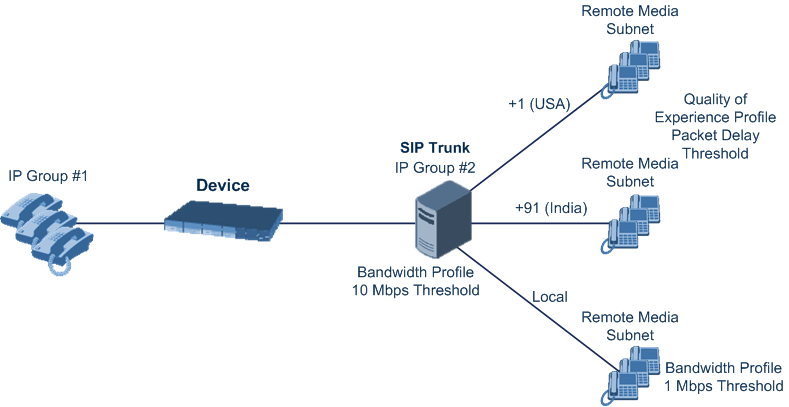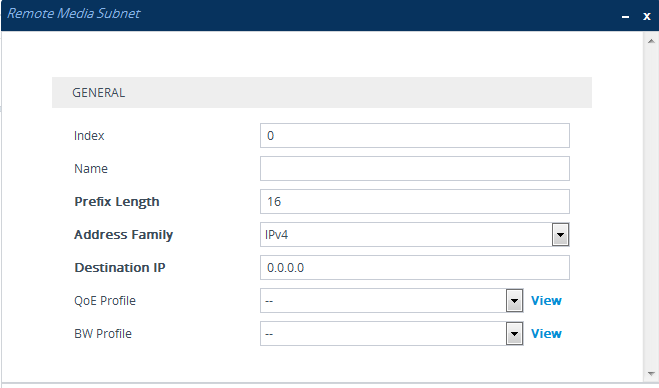Configuring Remote Media Subnets
Remote Media Subnets define destination subnets for media (RTP/SRTP) traffic on a specific Media Realm. Each Remote Media Subnet can be assigned different call quality (Quality of Experience Profile) and bandwidth utilization (Bandwidth Profile) profiles. These profiles are configured in Configuring Quality of Experience Profiles and Configuring Bandwidth Profiles, respectively. Thus, you can apply these profiles to remote media subnets instead of Media Realms or IP Groups. You can configure up to five Remote Media Subnets per Media Realm.
The figure below illustrates an example for implementing Remote Media Subnets. IP Group #2 represents a SIP Trunk which routes international (USA and India) and local calls. As international calls are typically more prone to higher delay than local calls, different Quality of Experience Profiles are assigned to them. This is done by creating Remote Media Subnets for each of these call destinations and assigning each Remote Media Subnet a different Quality of Experience Profile. A Quality of Experience Profile that defines a packet delay threshold is assigned to the international calls, which if crossed, a different IP Profile is used that defines higher traffic priority to voice over other traffic. In addition, IP Group #2 has a 10-Mbps bandwidth threshold and a "tighter" bandwidth limitation (e.g., 1 Mbps) is allocated to local calls. If this limit is exceeded, the device rejects new calls to this Remote Media Subnet.

The following procedure describes how to configure Remote Media Subnets through the Web interface. You can also configure it through ini file [RemoteMediaSubnet] or CLI (configure voip > remote-media-subnet).
| ➢ | To configure a Remote Media Subnet: |
| 1. | Open the Media Realms table (see Configuring Media Realms). |
| 2. | Select the Media Realm row for which you want to add Remote Media Subnets, and then click the Remote Media Subnet link located below the table; the Remote Media Subnet table appears. |
| 3. | Click New; the following dialog box appears: |

| 4. | Configure the Remote Media Subnet according to the parameters described in the table below. |
| 5. | Click Apply. |
Remote Media Subnet Table Parameter Descriptions
|
Parameter |
Description |
||||||
|---|---|---|---|---|---|---|---|
|
'Index' [RemoteMediaSubnet_RemoteMediaSubnetIndex] |
Defines an index number for the new table row. Note: Each row must be configured with a unique index. |
||||||
|
'Name' name [RemoteMediaSubnet_RemoteMediaSubnetName] |
Defines a descriptive name, which is used when associating the row in other tables. The valid value is a string of up to 20 characters. Note: Configure each row with a unique name. |
||||||
|
'Prefix Length' prefix-length [RemoteMediaSubnet_PrefixLength] |
Defines the subnet mask in Classless Inter-Domain Routing (CIDR) notation. For example, 16 denotes 255.255.0.0. The default is 16. |
||||||
|
'Address Family' address-family [RemoteMediaSubnet_AddressFamily] |
Defines the IP address protocol.
|
||||||
|
'Destination IP' dst-ip-address [RemoteMediaSubnet_DstIPAddress] |
Defines the IP address of the destination. The default is 0.0.0.0. |
||||||
|
'QoE Profile' qoe-profile [RemoteMediaSubnet_QOEProfileName] |
Assigns a Quality of Experience Profile to the Remote Media Subnet. By default, no value is defined. To configure QoE Profiles, see Configuring Quality of Experience Profiles. |
||||||
|
'BW Profile' bw-profile [RemoteMediaSubnet_BWProfileName] |
Assigns a Bandwidth Profile to the Remote Media Subnet. By default, no value is defined. To configure Bandwidth Profiles, see Configuring Bandwidth Profiles. |